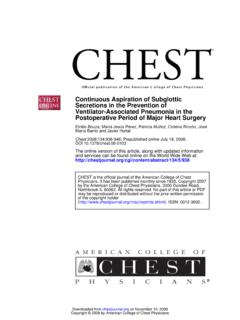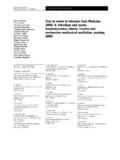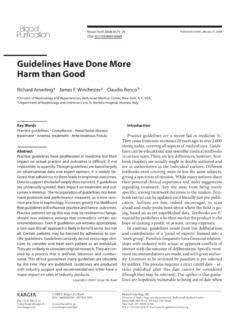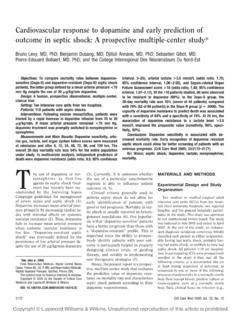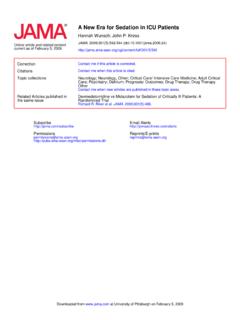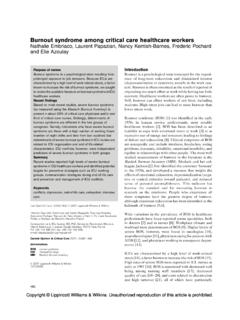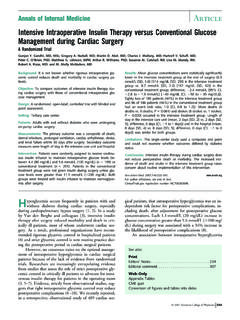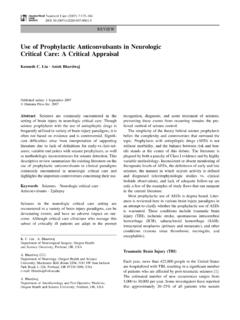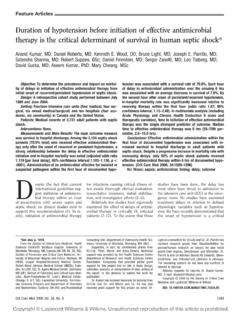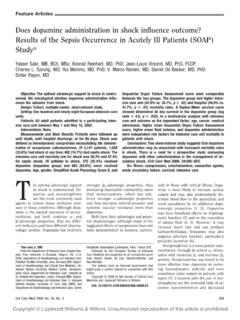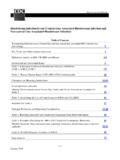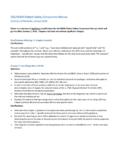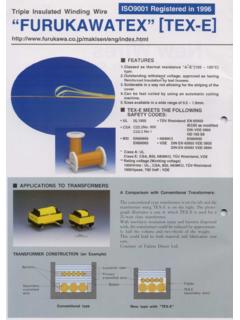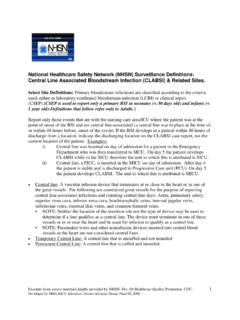Transcription of ORIGINAL INVESTIGATION Effectiveness of …
1 ORIGINAL INVESTIGATION . Effectiveness of chlorhexidine bathing to Reduce Catheter-Associated bloodstream infections in Medical Intensive Care Unit Patients Susan C. Bleasdale, MD; William E. Trick, MD; Ines M. Gonzalez, MD;. Rosie D. Lyles, MD; Mary K. Hayden, MD; Robert A. Weinstein, MD. Objective: To determine whether patients bathed daily come measures included incidences of primary BSIs and with chlorhexidine gluconate (CHG) have a lower inci- clinical (culture-negative) sepsis (primary outcomes) and dence of primary bloodstream infections (BSIs) com- incidences of other infections (secondary outcomes). pared with patients bathed with soap and water. Results: Patients in the CHG intervention arm were sig- Methods: The study design was a 52-week, 2-arm, cross- nificantly less likely to acquire a primary BSI ( vs over (ie, concurrent control group) clinical trial with in- infections per 1000 patient days; incidence difference, tention-to-treat analysis.)
2 The study setting was the 22- [95% confidence interval, ). The incidences of bed medical intensive care unit (MICU), which comprises other infections , including clinical sepsis, were similar 2 geographically separate, similar 11-bed units, of the John between the units. Protection against primary BSI by CHG. H. Stroger Jr (Cook County) Hospital, a 464-bed public cleansing was apparent after 5 or more days in the MICU. teaching hospital in Chicago, Illinois. The study popu- lation comprised 836 MICU patients. During the first of Conclusions: Daily cleansing of MICU patients with 2 study periods (28 weeks), 1 hospital unit was ran- CHG-impregnated cloths is a simple, effective strategy domly selected to serve as the intervention unit in which to decrease the rate of primary BSIs. patients were bathed daily with 2% CHG-impregnated washcloths (Sage 2% CHG cloths; Sage Products Inc, Cary, Trial Registration: Identifier: Illinois); patients in the concurrent control unit were bathed daily with soap and water.]
3 After a 2-week wash- NCT00130221. out period at the end of the first period, cleansing meth- ods were crossed over for 24 more weeks. Main out- Arch Intern Med. 2007;167(19):2073-2079. E. ACH YEAR , AN ESTIMATED longed residual effect, and superiority 80 000 patients in US inten- over iodophor skin preparations, is the sive care units (ICUs) in- recommended agent for disinfecting skin cur catheter-associated before catheter bloodstream infections (BSIs). Because of the impact on patient See also page 2066. outcomes and since many of these infec- tions are preventable, reduction in BSI risk Because catheter-associated BSI is usu- is the focus of several recent or ongoing ally caused by patients' resident skin flora, patient safety decolonization of a larger area of skin has Author Affiliations: Most catheter-associated BSIs result from contamination of the catheter by biological plausibility for reducing catheter- Departments of Medicine bacteria residing on patients' skin at the associated infection rates.
4 In a previous (Infectious Diseases). (Drs Bleasdale, Gonzales, time of device insertion, later from mi- study with historical controls,11 we found Hayden, and Weinstein), and croorganisms migrating from the skin to that compared with soap and water bath- Pathology (Dr Hayden), Rush catheter tip,6 or after catheter hub con- ing, daily bathing with CHG reduced mi- University Medical Center, and tamination, often also by patients' own crobial density on patients' skin, inci- Department of Medicine skin flora. The risk of BSI is reduced by dence of vancomycin-resistant enterococcal (Collaborative Research Unit) colonization, and BSI ,12 In the pres- antiseptic skin preparation immediately (Dr Trick) and Department of before catheter insertion and by keeping ent study, we report a new clinical trial Medicine (Infectious Diseases). (Drs Bleasdale, Gonzalez, Lyles, microbial density at the insertion site using concurrent controls and a crossover and Weinstein), Cook County low while the catheter is in ,7 design to test whether CHG cleansing Bureau of Health Services, chlorhexidine gluconate (CHG), which would decrease the incidence of primary Chicago, Illinois.
5 Has broad antimicrobial activity, pro- BSIs compared with soap and water baths. (REPRINTED) ARCH INTERN MED/ VOL 167 (NO. 19), OCT 22, 2007 2073. Downloaded from at University of Pittsburgh, on February 14, 2008. 2007 American Medical Association. All rights reserved. tient cleansing procedures during the second period, January 5 through June 21, 2006 (24 weeks) (Figure 1). We studied 2% chlorhexidine cloths Soap and water MICU A parallel units rather than randomly assigning the intervention at the patient level because a unit-level intervention likely would be more generalizable to use patterns outside of a study set- Soap and water 2% chlorhexidine cloths MICU B. ting, and the effect at the group level may reduce risk of in- traunit spread of pathogens between patients. Washout period bathing Procedure 28 weeks 2 weeks 24 weeks (June 8 December 20, 2005) (January 5 June 21, 2006) Nurses were instructed on the standardized bathing proce- dure relevant to their unit as described previously,11 with the following modifications.
6 For CHG baths, 8 cloths, rather than Figure 1. The crossover design. During the first 28-week period, medical 6, were used to clean patients' bodies up to the jawline, and 2. intensive care unit (MICU) A was randomly assigned as the intervention unit in which patients were bathed daily with 2% chlorhexidine nonmedicated cloths were used to clean patients' faces. For pa- gluconate impregnated cloths (Sage Products Inc, Cary, Illinois). Patients in tient comfort, packaged cloths were placed in a dedicated warmer the concurrent control unit were bathed daily with soap and water. This ( C) before use. For soap and water baths, nurses used warm period was followed by a 2-week washout period during which patients water in a disposable basin and bar soap (Pure Dial were bathed with soap and water in both units. We then crossed over the Corp, Scottsdale, Arizona) applied with 10 fresh terry cloth wash- patient cleansing procedures during the second 24-week period.
7 Cloths per bath. We monitored nurses' bathing technique in both arms episodically. METHODS All patients were bathed using the unit's designated proce- dure with the following exceptions. Patients in the CHG arm with greater than 20% body surface area disruption of skin in- DESIGN OVERVIEW tegrity, who declined participation or who developed a rash that might be attributed to CHG, were bathed with soap and water. This was a prospective, 2-arm, crossover (ie, concurrent con- trol group) clinical trial of daily bathing with no-rinse, 2% CHG- impregnated washcloths (Sage 2% chlorhexidine gluconate Data Collection cloths; Sage Products Inc, Cary, Illinois) vs soap and water bath- ing. The main study outcomes were primary BSI and clinical For all patients, we recorded age, sex, invasive device use (ie, in- (culture-negative) sepsis13; the secondary study outcome was travascular devices, urinary bladder catheters, mechanical venti- the occurrence of other nosocomial infections .)
8 The institu- lation, and feeding tubes), daily temperature, decubitus ulcers, he- tional review board waived the need for informed consent. modialysis, vasopressor and antibiotic receipt, APACHE II (Acute Physiology and Chronic Health Evaluation II) score, immunosup- SETTING AND PARTICIPANTS pressiveconditions(humanimmunodeficiency virus,diabetes,neu- tropenia, leukemia, and lymphoma), and in-unit mortality. We studied the medical ICU (MICU) at John H. Stroger Jr (Cook For infection surveillance, daily electronic review14 of micro- County) Hospital, a 464-bed public teaching hospital in Chi- biological cultures and new orders for antibiotic therapy were ob- cago, Illinois. The 22-bed MICU comprises 2 geographically tained for participants who were present in the MICU for more separate, similar 11-bed units. Each unit has a dedicated nurs- than 48 hours. To determine whether a patient had an infection ing staff; 1 team of attending and resident physicians cares for related to MICU stay, we performed a medical record review when- patients in both units.
9 The MICU catheter insertion policy man- ever a positive clinical culture was detected or a new order for dated sterile technique, full barrier drapes, and insertion site antibiotic therapy was given. Clinical and laboratory data were disinfection with 2% CHG; antiseptic- or antibiotic-coated cath- entered on standardized forms and evaluated independently by eters were not used. No other catheter-associated BSI infec- 3 physician investigators ( , , and ). The initial 2 re- tion control interventions were implemented during the study. viewers ( and ) were unblinded to intervention assign- We calculated a sample size to detect a 75% reduction of pri- ment; the third reviewer ( ) was blinded. Discrepant inter- mary BSI risk, a reduction consistent with results of our earlier pretations were adjudicated by discussion and consensus among Using previously collected data, we estimated MICU cen- the 3 reviewers; if uncertainties persisted, a fourth physician in- sus of 235 patient-days per unit per month and a primary BSI rate vestigator ( ), also blinded to intervention assignment, was of 12 per 1000 patient-days.
10 Setting the level at .05 and power consulted. To evaluate whether reviews were biased, we also cal- at 80%, we calculated a prespecified study duration of 12 months. culated BSI rates using a computer algorithm on a data ware- Agreement between investigator reviews and computer algorithm determinations was high ( = ), the same as ob- INTERVENTION served in a previous Also, there was no difference in level of agreement between arms (P=.82), suggesting that misclassi- Crossover fication bias during BSI determination was rare or nonexistent. Events prompting medical record review were categorized We divided the study into 2 periods. During the first, June 8 as noninfectious, infection related to MICU stay, or infection through December 20, 2005 (28 weeks), we randomly se- present or incubating before MICU admission. Using Centers lected one unit (MICU A) to serve as the intervention unit where for Disease Control and Prevention definitions,13 we classified patients were bathed daily with 2% CHG impregnated wash- infections that were determined to be related to MICU stay as cloths (Sage); this was designated the CHG arm.
